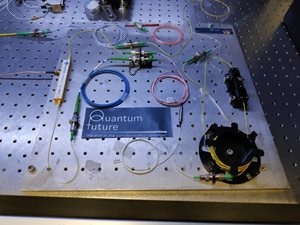May 7 2019
Scientists have created a simple and stable device to produce the quantum states essential for quantum key distribution. The device could make it more real-world to form a global data network that uses this very secure technique of encryption to safeguard everything from credit card transactions to texts.
 Researchers developed a fiber optic device that can switch the polarization of light more than 1 billion times per second. The device could be useful for quantum encryption data transmission in free-space links. (Image credit: Marco Avesani, University of Padova)
Researchers developed a fiber optic device that can switch the polarization of light more than 1 billion times per second. The device could be useful for quantum encryption data transmission in free-space links. (Image credit: Marco Avesani, University of Padova)
New encryption methods are necessary because computers strong enough to crack present-day algorithm-based encryption codes will probably be available in the next ten to twenty years. Instead of relying on math, quantum key distribution utilizes quantum properties of light such as polarization to encode and transmit a random key required to decrypt encoded data. The technique is remarkably secure because any third-party invasion is detectable.
In the Optical Society (OSA) journal Optics Letters, scientists from the University of Padova in Italy state that their all-fiber device can change the polarization of light over 1 billion times per second. The device is also self-compensating, making it impervious to temperature and other environmental deviations.
“Quantum key distribution is expected to have a deep impact in the privacy and security of citizens,” said Giuseppe Vallone, who led this study as a part of the QuantumFuture research group coordinated by co-author Paolo Villoresi. “Our scheme simplifies quantum key distribution for free-space communication — such as from satellites to Earth or between moving terminals — which is required to achieve a global quantum network.”
Developing a global network
Since quantum encryption does not work well over long-distance fiber networks, there is currently a push to create a satellite-based quantum communication network to connect numerous ground-based quantum encryption networks worldwide.
Although different properties of light can be used to form quantum states for quantum encryption, polarization is mainly well-matched for free-space links because it is not disturbed by the atmosphere and the decoding at the receiver can be performed without the difficult task of funneling the data into single mode fiber.
Our goal is to develop a quantum encryption scheme to use between a satellite and the ground, where the keys are generated in orbit. However, today’s polarization encoders aren’t ideal for use in space because they are unstable, expensive and complex. They can even exhibit side-channels that undermine the security of the protocol.
Giuseppe Vallone, Study Lead, QuantumFuture Research, University of Padova
Fast and stable polarization encoding
The new polarization encoder — which the scientists refer to as POGNAC for POlarization SaGNAC — can quickly rotate the polarization of incoming laser light owing to a fiber-loop Sagnac interferometer. This system splits the light into two beams whose polarizations are at right angles in relation to each other. The beams then move via the fiber-loop in clockwise and counterclockwise directions. The existing components can be fitted into a package that measures 15 x 5 x 5 cm, with further miniaturization possible if smaller components were added.
On the inner side of the fiber loop, the scientists used a commercially available electro-optics modulator to alter the polarization to form the quantum states essential for quantum key distribution. As the clockwise and anticlockwise components arrive at the modulator at various times, they can each be modulated individually.
Modulators use an applied voltage to alter the optical phase. However, the absolute value of the phase shift is governed by many factors that change with time.
In the POGNAC, only the relative shift between the two polarization components is relevant — this relative phase shift corresponds to a change in output polarization — while shifts that arise from temperature changes and other factors are self-corrected. This makes the POGNAC very stable and eliminates polarization drifts that have affected other devices.
Giuseppe Vallone, Study Lead, QuantumFuture Research, University of Padova
The scientists examined their new device by measuring the polarization of quantum states produced by the POGNAC and comparing them with the projected values. They calculated an intrinsic quantum bit error rate (QBER) as low as 0.2 %, quite below the 1-2% QBER of typical quantum key distribution systems.
“Our results show that data can be encoded using the polarization of light in a simple and efficient way,” said Vallone. “We were able to accomplish this using only commercially available components.”
The scientists will pursue improving their approach and plan to carry out more tests to see how the POGNAC functions when encoding quantum keys for encryption.